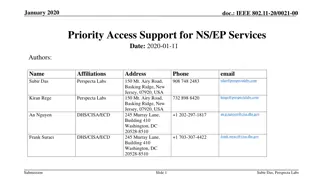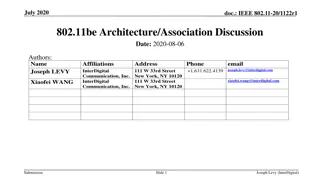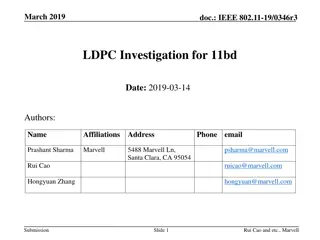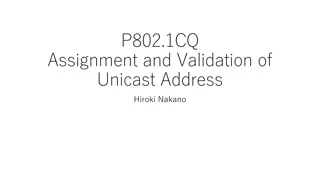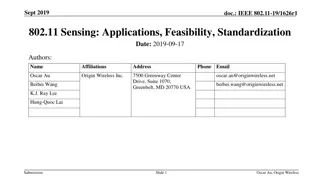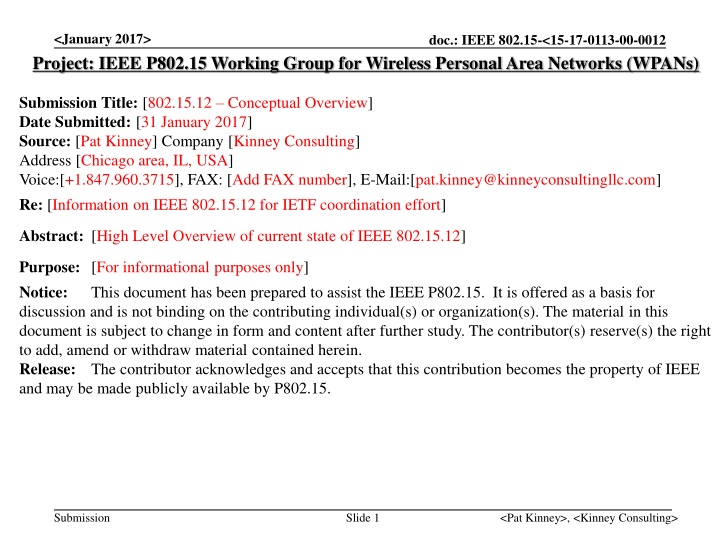
Overview of IEEE 802.15.12: Wireless Personal Area Networks (WPANs)
Discover the conceptual overview of IEEE 802.15.12, a crucial component for Wireless Personal Area Networks. Explore its functions, including configuration, higher layer protocols, fragmentation, and device management. Learn how IEEE 802.15.12 simplifies the complexities associated with configuring and using 802.15.4 devices.
Download Presentation

Please find below an Image/Link to download the presentation.
The content on the website is provided AS IS for your information and personal use only. It may not be sold, licensed, or shared on other websites without obtaining consent from the author. If you encounter any issues during the download, it is possible that the publisher has removed the file from their server.
You are allowed to download the files provided on this website for personal or commercial use, subject to the condition that they are used lawfully. All files are the property of their respective owners.
The content on the website is provided AS IS for your information and personal use only. It may not be sold, licensed, or shared on other websites without obtaining consent from the author.
E N D
Presentation Transcript
<January 2017> Project: IEEE P802.15 Working Group for Wireless Personal Area Networks (WPANs) doc.: IEEE 802.15-<15-17-0113-00-0012 Submission Title: [802.15.12 Conceptual Overview] Date Submitted: [31 January 2017] Source: [Pat Kinney] Company [Kinney Consulting] Address [Chicago area, IL, USA] Voice:[+1.847.960.3715], FAX: [Add FAX number], E-Mail:[pat.kinney@kinneyconsultingllc.com] Re: [Information on IEEE 802.15.12 for IETF coordination effort] Abstract: [High Level Overview of current state of IEEE 802.15.12] Purpose: [For informational purposes only] Notice: This document has been prepared to assist the IEEE P802.15. It is offered as a basis for discussion and is not binding on the contributing individual(s) or organization(s). The material in this document is subject to change in form and content after further study. The contributor(s) reserve(s) the right to add, amend or withdraw material contained herein. Release: The contributor acknowledges and accepts that this contribution becomes the property of IEEE and may be made publicly available by P802.15. Submission Slide 1 <Pat Kinney>, <Kinney Consulting>
<January 2017> doc.: IEEE 802.15-<15-17-0113-00-0012 802.15.12 Conceptual Overview Submission Slide 2 <Pat Kinney>, <Kinney Consulting>
<January 2017> doc.: IEEE 802.15-<15-17-0113-00-0012 IEEE 802.15.12 Introduction Introduction IEEE 802.15.12 performs many of the functions that an LLC would perform but adds additional functionality needed for IEEE 802.15.4 in areas such as configuration, higher layer protocol identity, fragmentation, harmonization of existing of other upper sublayer layer 2 protocols, and management of 802.15.4 devices. Purpose, to provide the following: Reduction of the complexity in configuring and using the 802.15.4 device Complexity in configuring 802.15.4 results from having to select one correct configuration given all possible combinations of the following: 8 MAC modes with 13 distinct MAC behaviors, 9 PHY modulation types with 4 distinct PHY behaviors and 40 PHY data rates, and 20 PHY bands with greater than 35,390 channels. 802.15.12 adds a management protocol module to provide configuration parameters to the 802.15.4 device. Complexity in the use of 802.15.4 to send messages is shown by a comparison with 802.3 and 802.11. Ethernet (802.3) has 4 parameters in its data transmission primitive while 802.11 has 6. However, the 802.15.4 data transmission primitive contains 28 parameters. See Figure 1 for more details. 802.15.12 supplies the additional MCPS parameters over and above 802.3 and 802.11. Submission Slide 3 Slide 3 <Pat Kinney>, <Kinney Consulting>
<January 2017> doc.: IEEE 802.15-<15-17-0113-00-0012 IEEE 802.15.12 Introduction Purpose (continued) provide the following: Addition of higher layer protocol identification An implicit assumption with 802.15.4 is that there is a single application/protocol stack above it, while other standards such as 802.3 and 802.11 use EtherType protocol identities to direct messages to one of many applications. 802.15.12 adds a header supplying higher layer protocol identification. Fragmentation While 802.15.4 needs fragmentation due to small frame sizes and low to very low data rates, 802.15.4 does not include frame fragmentation. 802.15.12 provides two fragmentation methods, one for 6LoWPAN operation and the other for all else. Harmonization There are numerous layer 2 protocols designed for 802.15.4, however these protocols have not been harmonized to allow combinations of these protocols. Management 802.15.4 was not originally intended to be managed, hence the standard did not include managed objects. 802.15.12 introduces managed objects to allow 802.15.4 devices to be managed similar to other devices such as 802.11. Submission Slide 4 Slide 4 <Pat Kinney>, <Kinney Consulting>
<January 2017> doc.: IEEE 802.15-<15-17-0113-00-0012 Data Request Comparison - Figure 1 As an example of the complexity of sending or receiving data with 802.15.4 compared to Ethernet or 802.11, the respective data request primitives are shown. 802.15.4 MCPS-DATA.request ( SrcAddrMode, DstAddrMode, DstPanId, DstAddr, Msdu, MsduHandle, HeaderIeList, PayloadIeList, HeaderIeIdList, NestedIeSubIdList, AckTx, GtsTx, IndirectTx, SecurityLevel, KeyIdMode, KeySource, KeyIndex, UwbPrf, Ranging, UwbPreambleSymbolRepetitions, DataRate, LocationEnhancingInformationPostamble, LocationEnhancingInformationPostambleLength, PanIdSuppressed, SeqNumSuppressed, SendMultipurpose FrakPolicy, CriticalEventMessage ) 802.3 MA_DATA.request ( destination_address, source_address, mac_service_data_unit, frame_check_sequence ) 802.11 MA-UNITDATA.request ( source address, destination address, routing information, data, priority, service class ) Submission Slide 5 Slide 5 <Pat Kinney>, <Kinney Consulting>
<January 2017> doc.: IEEE 802.15-<15-17-0113-00-0012 802.15.12 Functional Decomposition Overview: The 802.15.12 functional decomposition is based upon the 802- 2014 Reference Model. The functional decomposition as shown in Figure 2 enables: multiple higher layer applications and protocol stacks by use of the Protocol Discrimination Element (PDE). The PDE multiplexes the layer 3 interface to the appropriate protocol module all known Layer 2 protocols for 802.15.4, while still allowing extensibility to add protocols. These protocols are contained within the respective protocol modules. The protocol modules format the layer 3 datagrams into 802.15.4 primitives before transmission and extracts the incoming message from the 802.15.4 primitive for the appropriate layer 3 SAP all protocol modules access to the appropriate 802.15.4 SAP via the Multiplexed MAC Interface (MMI) fragmentation for datagrams, where fragmentation for 6LoWPAN is included in its protocol module and fragmentation for all other messages in included in the Multiplexed MAC Interface (MMI) Submission Slide 6 <Pat Kinney>, <Kinney Consulting>
<January 2017> doc.: IEEE 802.15-<15-17-0113-00-0012 PHY and DLL Functional Decomposition Figure 2 IPv6 Network Other Networks Applications Layer 3 and above EPD=0x86DD IPv6-SAP 6LON-SAP NWK-SAP AppD-SAP AppM-SAP 6LoWPAN -Optional- EPD=0xA0ED PDE Protocol Discrimination Entity (PDE) -Mandatory- IEEE 802.15.12 PTH-SAP VSH-SAP Rsv1H-SAP Rsv2H-SAP 6tH-SAP MPH-SAP RLSH-SAP .1XH-SAP KPH-SAP RUH-SAP Protocol Module EPD=0x888E RLS KMP (Key L2R (Layer 2 Routing) -Optional- Vendor Specific -Optional- Management Protocols -Mandatory- (Ranging & Location Support) -Optional- 802.1X -Optional- PassThru -Mandatory- Rsvd-1 -Optional- Rsvd-2 -Optional- 6top Management Protocol) -Optional- -Optional- PTM-SAP VSM-SAP Rsv1M-SAP Rsv2M-SAP 6tM-SAP MPM-SAP RLSM-SAP .1XM-SAP KPM-SAP RUM-SAP Layer 2 MMI Multiplexed MAC Interface (MMI) -Mandatory- MCPS-SAP MLME-SAP Beacon-enabled modes Nonbeacon-enabled modes Generic (GTS) -Optional- DSME -Optional- TSCH/BE -Optional- TSCH -Optional- LECIM (lp-wan) -Optional- RFID -Optional- RCC Generic -Optional- -Optional- MAC MAC optional behaviors Low Energy Channel Hopping IEEE 802.15.4 I.E.s TRLE Association Security Ranging SRU Priority Metrics Promiscuous SUN TVWS PD-SAP PLME-SAP Modulation type O-QPSK -Optional- BPSK -Optional- FSK MSK OFDM -Optional- CSS UWB - HRP -Optional- UWB - LRP -Optional- ASK Layer 1 -Optional- -Optional- -Optional- -Optional- PHY PHY optional behaviors Interleaver Data Whitener FEC PSDU FRAK Submission Slide 7 Slide 7 <Pat Kinney>, <Kinney Consulting>
<January 2017> doc.: IEEE 802.15-<15-17-0113-00-0012 802.15.12 Protocol Discrimination Entity (PDE) Purpose: Directs and optionally modifies information from the higher layer SAP to the appropriate protocol module directly or via fragmentation module Directs and optionally modifies information from protocol module SAP to the appropriate higher layer SAP directly or via defragmentation module Overview For frames going to the higher layer, the PDE determines the appropriate SAP for delivery, as determined by the ULI header, removes the ULI header, reconstitutes the appropriate header, and then directs the datagram to the SAP. For datagrams coming from a higher layer, the PDE determines the SAP to which the datagram is to be sent based upon the configuration of the device as set by the Management Protocols entity, and forwards it to the appropriate SAP. Further details may be found in 15-16-0656, latest revision Slide 8 Submission <Pat Kinney>, <Kinney Consulting>
<January 2017> doc.: IEEE 802.15-<15-17-0113-00-0012 802.15.12 Multiplexed MAC interface (MMI) Purpose Directs and may modify information from a protocol module SAP to the appropriate MAC SAP or another protocol module SAP Overview Provides multiplex and fragmentation service to the packets sent by the ULI functions and send them to either the MCPS-SAP, the MLME-SAP, or to another function module SAP within the ULI. The process of sending the packets includes formatting the ULI IE or prepending the appropriate headers into the payload of the frame for transmission. The interface between the MMI and the ULI function modules includes the Multiplex ID and the payload to be sent or the payload received. The mechanism for the MMI, i.e. the ability to send the data to the proper SAP, will be similar to the mechanism defined in IEEE 802.15.9 for the multiplexed data service. Further details may be found in 15-16-0656, latest revision. Submission Slide 9 <Pat Kinney>, <Kinney Consulting>
<January 2017> doc.: IEEE 802.15-<15-17-0113-00-0012 802.15.12 Protocol Modules Purpose: Formats messages from the higher layer SAP into the appropriate 802.15.4 primitive requests, e.g. MCPS-DATA.request, for the intended 802.15.4 SAP, or to the appropriate format for the intended protocol module. Responds to primitives from an 802.15.4 SAP in an appropriate manner such as sending the MPDU from a MCPS-DATA.indication to the appropriate higher layer SAP, or reacting to a confirm. Configures the necessary parameters of the 802.15.4 device for the intended operation such as network operation. Overview The Protocol Module acts as an intelligent interface from the higher layer SAP to the 802.15.4 SAP. The Protocol Module works with the PDE and MMI to allow an 802.15.4 device to handle multiple higher level applications. There are two mandatory protocol modules: Management Protocol and Slide 10 Submission PassThru. <Pat Kinney>, <Kinney Consulting>
<January 2017> doc.: IEEE 802.15-<15-17-0113-00-0012 802.15.12 Mandatory Protocol Modules Management protocol module provides: 1. Configuration parameters to the MAC and PHY using configuration data received from a higher layer 2. Configuration parameters to other protocol modules received from a higher layer or stored in the management protocol module Note: ULI Profile IDs, used to identify the device/module configuration, may need to be assigned by the 802.15 ANA for common profiles such as ULI device discovery, etc. However, proprietary configurations will be vendor specific. See 15-17-0050 for more information on ULI Profiles. 3. Network device monitoring or management. The monitoring function provides device monitoring metrics to a higher layer application. The management function uses data collected from the device to optimize the device s configuration for better spectral use. 4. Discovery services to detect other ULI capable devices. Submission Slide 11 <Pat Kinney>, <Kinney Consulting>
<January 2017> doc.: IEEE 802.15-<15-17-0113-00-0012 802.15.12 Mandatory Protocol Modules PassThru Module has the following functions: Allows applications/functions above the ULI to access the 802.15.4 device Generates an 802.15.4 primitive for messages from the upper layers as well as the 6LoWPAN protocol module to be passed via the 802.15.4 data SAP (MCPS-SAP) Responds to primitives (i.e. MCPS.DATA.confirm and MCPS.DATA.indication) delivered via the data SAP, such as passing the MPDU to a higher layer function Submission Slide 12 <Pat Kinney>, <Kinney Consulting>
<January 2017> doc.: IEEE 802.15-<15-17-0113-00-0012 802.15.12 Optional Protocol Modules 802.1X provides authentication, authorization, and cryptographic key agreement mechanisms to support secure communication between end stations connected to 802 networks. 802.15.9 (KMP) provides a methodology to enable key management by providing a transport for key management protocols outside the application layers. Additionally, provides a fragmentation and multiplexing layer for those packets so they can be delivered over smaller MAC layer frames and multiplexed on the recipient end to the right processing service. 802.15.10 (L2R) provides the following functions: topology construction, L2R mesh discovery/join/update/recovery, hop-by-hop retransmission, unicast/multicast/broadcast routing, data concatenation, short address assignment, and security Submission Slide 13 <Pat Kinney>, <Kinney Consulting>
<January 2017> doc.: IEEE 802.15-<15-17-0113-00-0012 802.15.12 Optional Protocol Modules 6LoWPAN provides the function of MAC frame modification into a frame format for transmission of IPv6 packets and the method of forming IPv6 link-local addresses and statelessly autoconfigured addresses on IEEE 802.15.4 networks. Additional functions include a header compression scheme using shared context and provisions for packet delivery in IEEE 802.15.4 mesh networks. 6tisch functions as an abstraction of an IP link over the TSCH mode of the MAC sublayer by providing network formation and maintenance, multi-hop topology, assign time source neighbor, resource management, dataflow control, scheduling mechanisms, and security. Ranging and Location Support (RLS): includes mechanisms for both passive gathering of location enabling information (from the MAC/PHY) and active messaging supporting two-way ranging (and other localization methods), and provides a higher layer application such as a location solver with the location enabling information or with a TOF estimate derived from this. Slide 14 Submission <Pat Kinney>, <Kinney Consulting>
<January 2017> doc.: IEEE 802.15-<15-17-0113-00-0012 802.15.12 Device Discovery Techniques To be able to determine how a message is to be transmitted from the 802.15.4 device, the 802.15.12 ULI will create and populate a table indicating devices that are ULI capable and IE capable. ULI capable: IE capable Reserved for use with devices using 15.4e-2012, or 15.4-2015 Payload IE, sent out with defined discovery payload Devices not understanding this IE will reject the IE with no ill effects Devices with 802.15.12 ULI will receive the IE and respond appropriately ULI capable: IE non-capable Reserved for use with devices using older firmware (< 2011), i.e. no IEs Defined discovery payload is sent using security with a well known ULI key Devices not knowing this key will reject packet with no ill effects Devices with 802.15.12 ULI will decrypt payload and respond appropriately Submission Slide 15 Slide 15 <Pat Kinney>, <Kinney Consulting>
<January 2017> doc.: IEEE 802.15-<15-17-0113-00-0012 802.15.12 Header construction: IE Devices ULI IE ID (dedicated to 6LoWPAN traffic) - ULI IE ID = total IE length (10 bits), 0b01??, 0b1 No Protocol Identifier is required, resulting in a total overhead of 2 octets MPX IE (used for all non-6LoWPAN traffic): Defined in 802.15.9, MPX IE ID = total IE length (10 bits), 0b0011, 0b1 MPX IE has a length of 2 octets, followed by a transaction control of 1 octet, followed by a Protocol Identifier of 2 octets for a total overhead of 5 octets For the special case where the dispatch code is < 0x001f, the 2-octet Dispatch code is elided, resulting in a total overhead of 3 octets Protocol Identifiers: - EtherType values are > 0x0600 - Dispatch values assigned by 802.15 ANA are < 0x4FF - Vendor specific values will be set to 0x565 followed by a 3-octet OUI for that vendor Submission Slide 16 <Pat Kinney>, <Kinney Consulting>
<January 2017> doc.: IEEE 802.15-<15-17-0113-00-0012 802.15.12 Header construction: Non-IE devices Non-IE devices - 1st payload octet is set to 0xff in accordance with 6LoWPAN Paging Dispatch - 2nd payload octet denotes page 15 and will be defined in the future - 3rd and 4th payload octets denote the Protocol Identifier Note: Non-IE device discovery will use the security mechanism with a well known key to effect a discovery ULI packet that will not disturb non-ULI devices. Those 802.15.4 devices not responding to this discovery packet could be assumed to be non-ULI (multiple discovery packets should be sent since a packet may not be received) Protocol Identifiers: - EtherType values are > 0x0600 - Dispatch values assigned by 802.15 ANA are < 0x4FF - Vendor specific values will be set to 0x565 followed by a 3-octet OUI for that vendor Submission Slide 17 <Pat Kinney>, <Kinney Consulting>
<January 2017> doc.: IEEE 802.15-<15-17-0113-00-0012 Examples of Frame Construction with 802.15.12 The basic assumptions for the following examples of data frames are: 2-octet Frame Check Sequence 2-octet short addresses Origination and Destination devices in same PAN (source PAN ID elided) Security enabled using 4-octet MIC Sequence number is present No header IEs Three examples of 802.15.4 data frames using 802.15.12 are shown in the following figures 3 and 4. The examples are: Figure 3 - 802.15.4 devices are not IE capable, hence the ULI message is in the payload Figure 4 802.15.4 devices are IE capable, hence ULI message is in an IE Figure 4a MPX IE used for all non-6LoWPAN messages Figure 4b ULI IE used only for 6LoWPAN messages Submission Slide 18 <Pat Kinney>, <Kinney Consulting>
<January 2017> doc.: IEEE 802.15-<15-17-0113-00-0012 Frame Composition 4 3 2 2 2/7 1 Figure 3 EtherType /Dispatch ULI header IPHC NHC 802.15.12 6LoWPAN MAC Payload 2 1 2 2 0 2 1 1 4 1 0 0 4 4 3 Max Frame Size - all other fields 2 0/1/5/9 Key Identifier 0/4 Frame Counter 0/2 Dest PAN ID 0/2/8 Dest Addr 0/2 Source PAN ID 0/2/8 Source Addr Octets: 2 0/1 3/8 0/4/8/16 2/4 4 Variable Security Control Frame Control Sequence Number FCS 6LoWPAN Header ULI Header Data Payload MIC Auxiliary Security Header (optional) IEEE 802.15.4 MAC frame Addressing Fields MFR MHR MAC Payload Using Data Payload to convey higher layer data Figure 4a Figure 4b 2 3 Variable 5 Variable Variable 2 2/7 1 Variable 2 1 2 Variable Variable Transaction Control 802.15.12 EtherType / Dispatch L3 L4 ULI-6lo ID Payload IPHC NHC MPX ID Payload Header Layer 3 Header Layer 4 Layers 5-7 802.15.12 6LoWPAN Layers 5-7 Payload IE Payload IE 2 1 2 2 0 2 1 1 4 1 0 Variable Variable Max Frame Size - all other fields 4 2 0/1/5/9 Key Identifier 0/4 Frame Counter 0/2 Dest PAN ID 0/2/8 Dest Addr 0/2 Source PAN ID 0/2/8 Source Addr Variable 0/4/8/16 2/4 Octets: 2 0/1 Variable Security Control Header IEs Payload IEs Frame Control Sequence Number FCS Data Payload MIC Auxiliary Security Header (optional) IEEE 802.15.4 MAC frame Addressing Fields MHR MAC Payload MFR Using IEs to convey higher layer data Submission Slide 19 Slide 19 <Pat Kinney>, <Kinney Consulting>
<January 2017> doc.: IEEE 802.15-<15-17-0113-00-0012 Examples of IP Packet Construction using 802.15.12 Figure 5 shows six examples of IP packets using 802.15.12: IE messaging of non-compressed UDP/IPv6 IE messaging of non-compressed UDP/IPv4 IE messaging of compressed UDP/IPv6 using 6LoWPAN Non-IE messaging of non-compressed UDP/IPv6 Non-IE messaging of non-compressed UDP/IPv4 Non-IE messaging of compressed UDP/IPv6 using 6LoWPAN All examples use the basic assumptions for frame construction from the previous Frame Construction examples resulting in a 21-octet MAC overhead The 6LoWPAN examples are for non-fragmented, no mesh; yielding a 3- octet overhead As indicated, the total (MAC + ULI + IP + UDP) header lengths for the six examples range from 26 octets to 74 octets Submission Slide 20 <Pat Kinney>, <Kinney Consulting>
<January 2017> doc.: IEEE 802.15-<15-17-0113-00-0012 Packet Construction - Figure 5 Layer 2 Header Frame Check Sequence PHY Header Layer 3 Header Layer 4 Header Application Payload MAC Header ULI Header 21 octets 2 octets 1 octet 2 octets 40 octets 8 octets 74 Octets Overhead Protocol Identifier = 0x86DD Transaction Control Uncompressed IPv6 MAC MPX IE IPv6 UDP 21 octets 2 octets 1 octet 2 octets 20 octets 8 octets 54 Octets Overhead Uncompressed IPv4 Protocol Identifier = 0x0800 IE Transaction Control MAC MPX IE IPv4 UDP Messaging 21 octets 2 octets 2 octets 1 octet 26 Octets Overhead IPHC NHC 6LoWPAN MAC ULI IE 6LoWPAN 21 octets 2 octets 2 octets 40 octets 8 octets 73 Octets Overhead Protocol Identifier = 0x86DD Uncompressed IPv6 ULI Header 0xff, TBD MAC IPv6 UDP 21 octets 2 octets 2 octets 20 octets 8 octets Non-IE Messaging 53 Octets Overhead Uncompressed IPv4 Protocol Identifier = 0x0800 ULI Header 0xff, TBD MAC IPv4 UDP 21 octets 2 octets 2 octets 2 octets 1 octet 28 Octets Overhead 6LoWPAN IPHC NHC Protocol Identifier = 0xA0ED ULI Header 0xff, TBD MAC 6LoWPAN Submission Slide 21 <Pat Kinney>, <Kinney Consulting>
<January 2017> doc.: IEEE 802.15-<15-17-0113-00-0012 Conclusion Mandatory elements still to be done: PDE Primitives Parameters Behavior MMI Primitives Parameters Behavior Management protocol module Primitives Parameters Behavior Pass-thru protocol module Primitives Parameters Behavior Networking management managed objects protocols Submission Slide 22 <Pat Kinney>, <Kinney Consulting>
<January 2017> doc.: IEEE 802.15-<15-17-0113-00-0012 Conclusion (continued) Optional Protocol Modules intended to be done: 6LoWPAN Primitives Parameters Behavior Key Management Protocol (KMP) Primitives Parameters Behavior Layer 2 Routing (L2R) Primitives Parameters Behavior 6top (layer 2 portion of 6tisch) Primitives Parameters Behavior Ranging & Location Support (RLS) Primitives Parameters Behavior Submission Slide 23 <Pat Kinney>, <Kinney Consulting>






